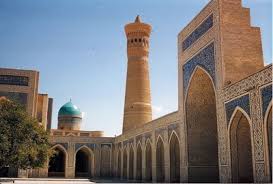Whilst Kyrgyzstan
is without doubt my favourite country in Central Asia, Bukhara in Uzbekistan remains my favourite city.
Bukhara has
seen it all. Alexander the Great passed this way. When the Horde ransacked the city, Genghis Khan marvelled at the
Kalyan minaret, before using it to fling his victims to their deaths. When survivors eventually returned to the remains of their city they renamed it the Tower of Death.
 |
| Kaylan Minaret |
The extremely bad tempered 19th
Century Emir- Nasrulla, favoured lingering deaths for his victims in a bug infested pit, including two unfortunate British Officers which he eventually beheaded. He finally fled the advancing Russians to Tajikistan,
leaving a trail of dancing boys in his wake as an unsuccessful diversion.
Bukhara had
the greatest collection of madrasas in Central Asia before the communists arrived and left them to fade away.
It was also a disease infested place with many
of the inhabitants suffering from guinea worm known locally as Bukhara boil, contracted from the pools of
water built in this desert oasis for people to wash, bathe and drink from. One of
the first actions of the Russian regime was to fill these pools in, and to
construct alternative water supplies, leaving only the marvellous pool of Layb-I- Khauz and its chai khanas intact.
 |
Taking tea at the pool of Layb-I-Khauz
|
The Ark was
the Citadel of the Emir and it was in front of these gates that the bodies of
Stoddart and Conolly the two British Officers were buried.
 |
The Ark
|
Walking
through Bukhara is history brought to life. Bukhara Burnes may have
travelled this way only a week or two before instead of 186 years ago. For over 2000 years Bukhara has
played a key role in the region, from stop overs on the Silk Road to the Great
Game.

